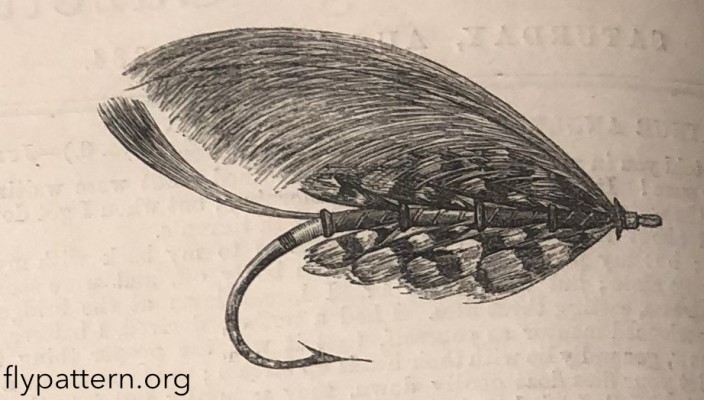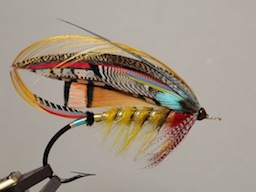From "The fishing gazette" - August 9th, 1884
WHETHER it be in fly dressing or other pursuit in life, blighted hope, if not failure, is well within the bounds of probability, unless we can conveniently secure a fairly good start. Amateurs who have followed me so far should, I hope, be able to manage the tag and tail successfully. Perhaps it is as well to say that in adjusting toppings at the tail, though I scarcely thought it neccessary to refer to them here, the tying silk should extend up to (not over) the fibres, and after two turns, the quill end of the feather, which should have been inclining rather towards you, is lifted up and placed straight along the top of the hook before proceeding. If this feather is not put in a diagonal position at first, the silk in unskilled hands is almost sure to drag it over - beyond the hook; consequently, the dent in the shaft of the feather is made out of place, and spolis all chance of its posing well when offered its proper seat afterwards, leaving no remedy but to shorten it, or keep it for a smaller fly. Prior to my getting these feathers under control, I used to make the dent beforehand with a spatula, and found it answered well.
As we require double the amount of scraggy or spare herls for butts, select those dyed a good black, and with short, close filaments; for the fewer coils we have of them the better, as a salmon's tooth often effects so much mischief here. Always try the strength of them. The dye, if hot, weakens them considerably; but if cold, and the feather fresh from the bird, they will keep for years stored away from light and air. The hairy fragments should always face the tag. Wool butts are becoming popular only because they last much longer. They should have a symmetrical oval outline, which is not difficult if you dishevel and unravel your wool well, make a "pea" of it, and roll it a little between the palms of your hands, as a plumber would his putty; then lay it down and give it a skin-deep pull right and left to form a double taper, say an inch long. Apply one end behind the tying silk, under and against the hook, and press it there with the first finger of the left hand. Guide it alongside the silk, if it requires guiding (but it generally hangs down sufficiently straight), and by taking that end between the thumb and forefinger of the right hand with the silk you can twist both together, and they will unite if you hold the left finger as directed. In repeating the twisting motion, which you have to do when the thumb which started at the first finger-joint reaches the end of that finger, take care, before you leave go, to drag them both down the whole of the tying silk to maintain the twist throughout, otherwise your work will retreat, fly back, and then you will have to begin again. And here I may mention there are other qualifications expected of butts besides long life; so even if herls have a "touch-and-go" reputation - if they are minute in importance - they are more attractive and enticing while they last.
It is astonishing how Fishermen delight in building their recollections upon basis of reality, and although there may be little else to urge beyond the function of imagination, why we fancy this and that in preference to the other, it is no less true there are other facts to all appearance equally insignificant - verities, though only gathered in twilight by degrees which should not simply be unveiled to hover around us, but should assuredly concern and, undoubtedly, direct us. Undoubtedly - perhaps too strong an expression this - for how often, how very often, between the desire and its fulfillment lies only the briefest space of time, and the desire remains for ever unfulfilled! The sad and sudden death of the king of anglers, Major French, surrounded - poor fellow - by little else but his feathers and fishing gear, in which he manifested such pardonable pride, is so remindful how the joys and sorrows of this world may be strikingly mingled. I trust any, or so brief an allusion is not entirely out of place; but indeed, salmon fishermen have lost a true, noble-hearted man, who was always most happy when he could in any way contribute to the happiness of others. I hope I may be excused for this digression.
In returning to our subject, perhaps I need not say much now of the tinsel tribe. The first turn of the tying silk beyond the butt should be over the substratum of oval tinsel which is tied in here for ribs. I have previously suggested how and why it is to be "peeled;" but at this point it requires a little different management.
An extravagant, still, a good plan, for maneuvring a taper for the body - one which I used to adopt, because in my early days I found it difficult to gradually and regularly increase the amount of outside material - is to divest sufficient tinsel to allow enough of its internal silk for the purpose. It may be waxed with cobbler's wax for a seal's fur body, then one turn only of the tying silk is enough by the butt. Spread out or widen the first coil or two considerably, and from there with ordinary management you have an area every atom as firm to work upon - a foundation that answers admirably.
In my opinion, there is no wax so good as this for salmon flies - nothing, in fact, approaches it; bodies are stronger and more durable over its clinging grasp, and it alike strengthens all parts of the fly. Dressers who are very familiar with its use know exactly when to drop or shift it to avoid waxing their fingers; and those less au fait would do well to put a small quantitiy in a piece of kid or thin leather the size and shape of a five-shilling piece, which should be kept doubled, as exposure is detrimental. When waxting thread, it is unnecessary to open this wad all the way, but merely down to where the wax has spread; the pressure is with the forefinger above the gossamer silk, on the four strands which you hold horizontally after having put them twice over the "fly-maker's peg". When the wax is soft it works best. As to "spoiling the colour of the silk," if the correspondent last week meant the colour of his floss when worked over the waxed tying silk - and we may fairly assume he intended to convey that idea, because it is immaterial what colour the tying silk turns, as it is hidden from the tag to the head - he should either be more sparing with wax, or more generous with his floss silk. If there is a scarcity of the latter, it will be sure to turn a bad colour in, if it does not out of the water.
I need not resort to the sophistry of foreign phrases - a fashion, frivolous and fast fading away - for the object of apparently fortifying any observations in favour of the "Don." However perfect this fly appears (and the harmony as usual reveals superior skill, and must be commendably acknowledged), though it derives its origin from so authentic a source as "to make assurance doubly sure," we can but draw an inference only of its certitude. With such startling prominence in the composition, it bids fair to run many of its precious predecessors uncommonly hard.
All fishermen know that "Jungle" is most conspicuous, and when once salmon become accustomed to it, there is always a special demand for the feathers, which may well be attributed to their captivating qualities and exercising infuence.
There is a very general opinion current that this useful bird is rendered more valuable when the spots are black and brown. In presence of this mistaken spirit of toleration, may I ask (and I do so with a deal of confidence), Is there an experienced Fisherman living who makes his own flies that will not condemn such utter fallacy? We use it because it is easily and clearly seen in the water; the greater the contrast the greater the attraction, and is there not a wide difference between black and brown and black and white? Want of faith is an unenjoyable hindrance to success. If anyone is, therefore, in doubt about Jungle fowl, let him be persevering with the larger feathers in rough, deep pools, reserving the more diminutive for steadier flowing streams. To enjoy is to live in the instant we grasp, and how can we be hopeful if we are deficient in faith? There may not be much in anticipation, but it invariably lends encouragement, even though it frequently forgets to fulfil what it promises. The forecasts of fishermen are, however, often frustrated - proved void - though the water and weather be never so favorable: uncommonly suggestive that "that which is least expected will be sure to transpire" is about our only safe and sound matutinal prediction.
In preface to the description of our illustration, I may mention that we can - not absolutely depend upon the "rights" and "lefts" of these feathers, which with others (golden toppings omitted) is important. Upon more than one occasion I have come across necks when, from the unusual - I may almost say deformed-shape of the shaft, utterly precluded the idea of fixing those on that side of the fly for which they are presumably intended. I am given to understand that this anomaly arises from the constant habit some of the birds have of always roosting with the head under the same wing; but we can fortunately fit all their feathers to advantage somewhere, and whether large or small, so long as they are velvety black and a pure white, they are most useful and invaluable to salmon anglers.
Tag: Silver twist, and silk the same colour as toppings.
Tail: Topping.
Butt: Black herl.
Body: In four sections, butted, and with two jungle feathers back to back top and bottom, as shown. No. 1 division: Green silk, same shade as the green feather of the macaw. 2: Tippet-coloured silk. 3. Dark blue silk same tone as an enamelled thrush. 4. Black silk.
Ribbed: Oval tinsel.
Wings: Toppings.
Horns: Blue macaw.
Head: Black herl.
|

